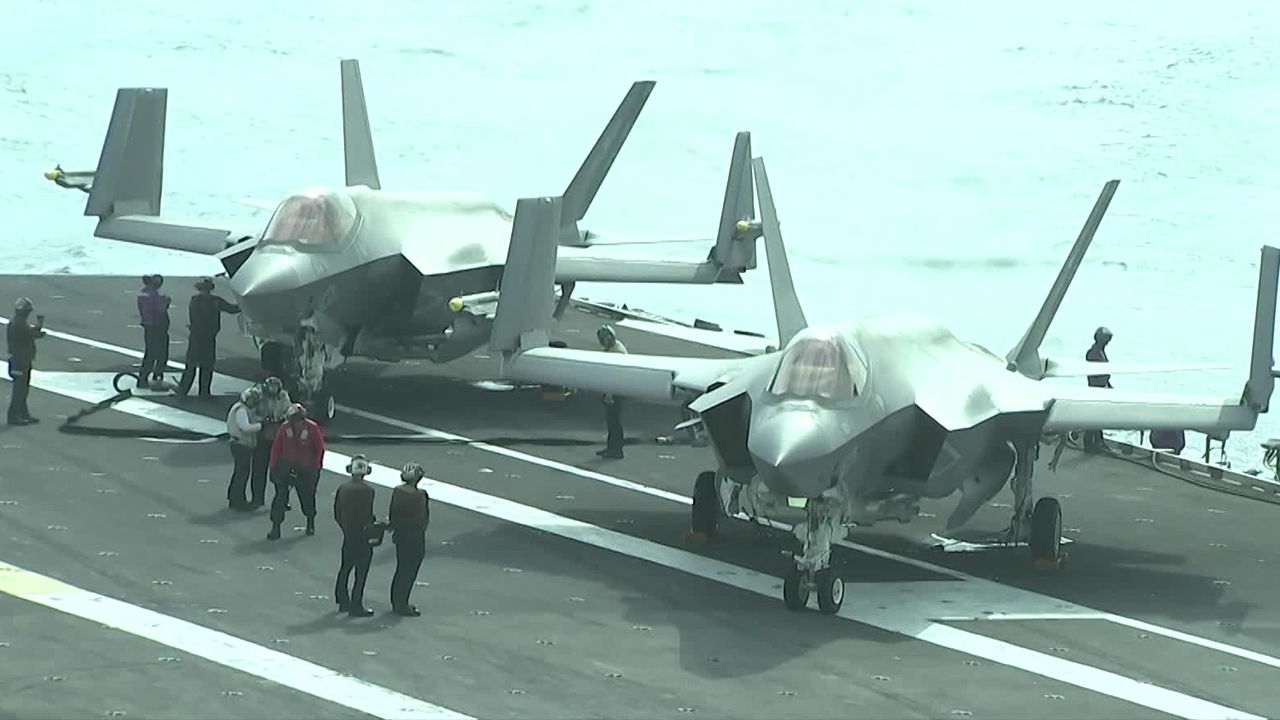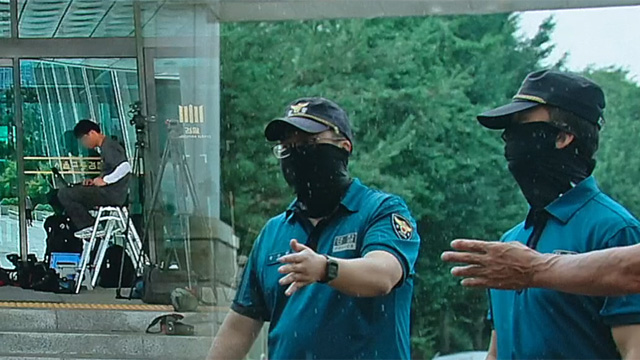US, S. Korea, and Japan hold joint military exercise to deter North Korean provocations
입력 2024.11.14 (23:55)
읽어주기 기능은 크롬기반의
브라우저에서만 사용하실 수 있습니다.
[Anchor]
Joint exercises among South Korea, the United States, and Japan have been conducted to deter North Korea's provocative threats.
This exercise involved the deployment of U.S. nuclear aircraft carriers, Aegis ships, stealth fighters, and was carried out simultaneously at sea and in the air.
Reporter Kim Yong-jun has the story.
[Report]
The USS George Washington, a massive nuclear-powered aircraft carrier three times the size of a soccer field and capable of accommodating about 80 aircraft, has set sail in the waters south of Jeju.
Alongside the George Washington, Aegis destroyers from South Korea, the U.S., and Japan, capable of detecting and intercepting North Korean missiles, have also gathered.
In the sky, U.S. Navy F-35C carrier-borne stealth fighter jets are flying in formation with South Korea's F-35A stealth fighters and Japan's F-15J.
After completing its mission, the F-35C lands on the aircraft carrier, while an F-18 fighter jet on standby makes an emergency launch.
The F-35C jets, fully loaded on the aircraft carrier, can carry bunker-buster bombs designed to destroy underground core facilities, and its operational range exceeds approximately 1,000km, making it undetectable and unprepared for any means from North Korea when launched from the waters south of Jeju.
For this reason, simply moving the U.S. nuclear aircraft carrier around the Korean Peninsula can exert a strong deterrent effect.
Since last year's agreement at the U.S. Camp David summit, South Korea, the U.S., and Japan have demonstrated their resolve to respond to North Korea's provocations through the second Korea-U.S.-Japan Freedom Edge exercise, which is the first joint air exercise composed solely of fighter jets from the three countries without strategic air assets.
[Heo Seong-jae/Commander of the 7th Naval Flotilla/Brigadier General: "You can see this exercise as a reflection of our will to deter and respond to threats that undermine peace and stability in the Korean Peninsula and the Indo-Pacific region, such as North Korea's recent ICBM launches."]
The Joint Chiefs of Staff explained that this exercise focused on how the three countries would coordinate in case of an emergency, primarily involving operational personnel.
It is understood that South Korea, the U.S., and Japan have agreed to conduct scenario-based training for various types of provocations, including North Korea's hypersonic missiles, starting from the third exercise.
KBS News, Kim Yong-jun.
Joint exercises among South Korea, the United States, and Japan have been conducted to deter North Korea's provocative threats.
This exercise involved the deployment of U.S. nuclear aircraft carriers, Aegis ships, stealth fighters, and was carried out simultaneously at sea and in the air.
Reporter Kim Yong-jun has the story.
[Report]
The USS George Washington, a massive nuclear-powered aircraft carrier three times the size of a soccer field and capable of accommodating about 80 aircraft, has set sail in the waters south of Jeju.
Alongside the George Washington, Aegis destroyers from South Korea, the U.S., and Japan, capable of detecting and intercepting North Korean missiles, have also gathered.
In the sky, U.S. Navy F-35C carrier-borne stealth fighter jets are flying in formation with South Korea's F-35A stealth fighters and Japan's F-15J.
After completing its mission, the F-35C lands on the aircraft carrier, while an F-18 fighter jet on standby makes an emergency launch.
The F-35C jets, fully loaded on the aircraft carrier, can carry bunker-buster bombs designed to destroy underground core facilities, and its operational range exceeds approximately 1,000km, making it undetectable and unprepared for any means from North Korea when launched from the waters south of Jeju.
For this reason, simply moving the U.S. nuclear aircraft carrier around the Korean Peninsula can exert a strong deterrent effect.
Since last year's agreement at the U.S. Camp David summit, South Korea, the U.S., and Japan have demonstrated their resolve to respond to North Korea's provocations through the second Korea-U.S.-Japan Freedom Edge exercise, which is the first joint air exercise composed solely of fighter jets from the three countries without strategic air assets.
[Heo Seong-jae/Commander of the 7th Naval Flotilla/Brigadier General: "You can see this exercise as a reflection of our will to deter and respond to threats that undermine peace and stability in the Korean Peninsula and the Indo-Pacific region, such as North Korea's recent ICBM launches."]
The Joint Chiefs of Staff explained that this exercise focused on how the three countries would coordinate in case of an emergency, primarily involving operational personnel.
It is understood that South Korea, the U.S., and Japan have agreed to conduct scenario-based training for various types of provocations, including North Korea's hypersonic missiles, starting from the third exercise.
KBS News, Kim Yong-jun.
■ 제보하기
▷ 카카오톡 : 'KBS제보' 검색, 채널 추가
▷ 전화 : 02-781-1234, 4444
▷ 이메일 : kbs1234@kbs.co.kr
▷ 유튜브, 네이버, 카카오에서도 KBS뉴스를 구독해주세요!
- US, S. Korea, and Japan hold joint military exercise to deter North Korean provocations
-
- 입력 2024-11-14 23:55:18

[Anchor]
Joint exercises among South Korea, the United States, and Japan have been conducted to deter North Korea's provocative threats.
This exercise involved the deployment of U.S. nuclear aircraft carriers, Aegis ships, stealth fighters, and was carried out simultaneously at sea and in the air.
Reporter Kim Yong-jun has the story.
[Report]
The USS George Washington, a massive nuclear-powered aircraft carrier three times the size of a soccer field and capable of accommodating about 80 aircraft, has set sail in the waters south of Jeju.
Alongside the George Washington, Aegis destroyers from South Korea, the U.S., and Japan, capable of detecting and intercepting North Korean missiles, have also gathered.
In the sky, U.S. Navy F-35C carrier-borne stealth fighter jets are flying in formation with South Korea's F-35A stealth fighters and Japan's F-15J.
After completing its mission, the F-35C lands on the aircraft carrier, while an F-18 fighter jet on standby makes an emergency launch.
The F-35C jets, fully loaded on the aircraft carrier, can carry bunker-buster bombs designed to destroy underground core facilities, and its operational range exceeds approximately 1,000km, making it undetectable and unprepared for any means from North Korea when launched from the waters south of Jeju.
For this reason, simply moving the U.S. nuclear aircraft carrier around the Korean Peninsula can exert a strong deterrent effect.
Since last year's agreement at the U.S. Camp David summit, South Korea, the U.S., and Japan have demonstrated their resolve to respond to North Korea's provocations through the second Korea-U.S.-Japan Freedom Edge exercise, which is the first joint air exercise composed solely of fighter jets from the three countries without strategic air assets.
[Heo Seong-jae/Commander of the 7th Naval Flotilla/Brigadier General: "You can see this exercise as a reflection of our will to deter and respond to threats that undermine peace and stability in the Korean Peninsula and the Indo-Pacific region, such as North Korea's recent ICBM launches."]
The Joint Chiefs of Staff explained that this exercise focused on how the three countries would coordinate in case of an emergency, primarily involving operational personnel.
It is understood that South Korea, the U.S., and Japan have agreed to conduct scenario-based training for various types of provocations, including North Korea's hypersonic missiles, starting from the third exercise.
KBS News, Kim Yong-jun.
Joint exercises among South Korea, the United States, and Japan have been conducted to deter North Korea's provocative threats.
This exercise involved the deployment of U.S. nuclear aircraft carriers, Aegis ships, stealth fighters, and was carried out simultaneously at sea and in the air.
Reporter Kim Yong-jun has the story.
[Report]
The USS George Washington, a massive nuclear-powered aircraft carrier three times the size of a soccer field and capable of accommodating about 80 aircraft, has set sail in the waters south of Jeju.
Alongside the George Washington, Aegis destroyers from South Korea, the U.S., and Japan, capable of detecting and intercepting North Korean missiles, have also gathered.
In the sky, U.S. Navy F-35C carrier-borne stealth fighter jets are flying in formation with South Korea's F-35A stealth fighters and Japan's F-15J.
After completing its mission, the F-35C lands on the aircraft carrier, while an F-18 fighter jet on standby makes an emergency launch.
The F-35C jets, fully loaded on the aircraft carrier, can carry bunker-buster bombs designed to destroy underground core facilities, and its operational range exceeds approximately 1,000km, making it undetectable and unprepared for any means from North Korea when launched from the waters south of Jeju.
For this reason, simply moving the U.S. nuclear aircraft carrier around the Korean Peninsula can exert a strong deterrent effect.
Since last year's agreement at the U.S. Camp David summit, South Korea, the U.S., and Japan have demonstrated their resolve to respond to North Korea's provocations through the second Korea-U.S.-Japan Freedom Edge exercise, which is the first joint air exercise composed solely of fighter jets from the three countries without strategic air assets.
[Heo Seong-jae/Commander of the 7th Naval Flotilla/Brigadier General: "You can see this exercise as a reflection of our will to deter and respond to threats that undermine peace and stability in the Korean Peninsula and the Indo-Pacific region, such as North Korea's recent ICBM launches."]
The Joint Chiefs of Staff explained that this exercise focused on how the three countries would coordinate in case of an emergency, primarily involving operational personnel.
It is understood that South Korea, the U.S., and Japan have agreed to conduct scenario-based training for various types of provocations, including North Korea's hypersonic missiles, starting from the third exercise.
KBS News, Kim Yong-jun.
-
-

김용준 기자 okok@kbs.co.kr
김용준 기자의 기사 모음
-
이 기사가 좋으셨다면
-
좋아요
0
-
응원해요
0
-
후속 원해요
0










![[단독] “윤석열·김용현 등 공모해 군사상 이익 해쳐”<br>…외환죄 대신 일반이적죄 적용](/data/layer/904/2025/07/20250714_3VTJV3.jpg)




이 기사에 대한 의견을 남겨주세요.